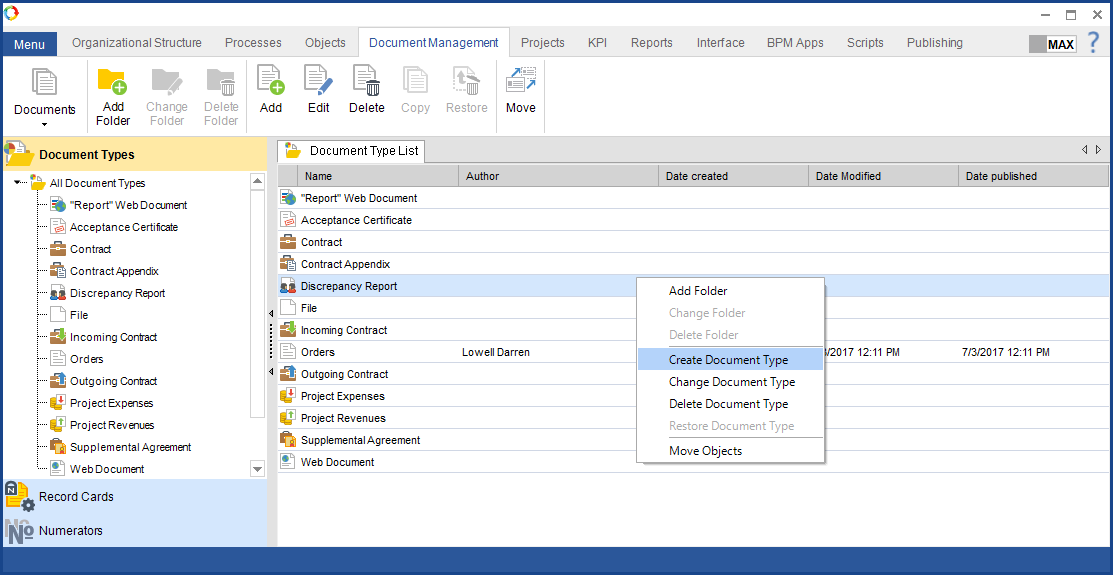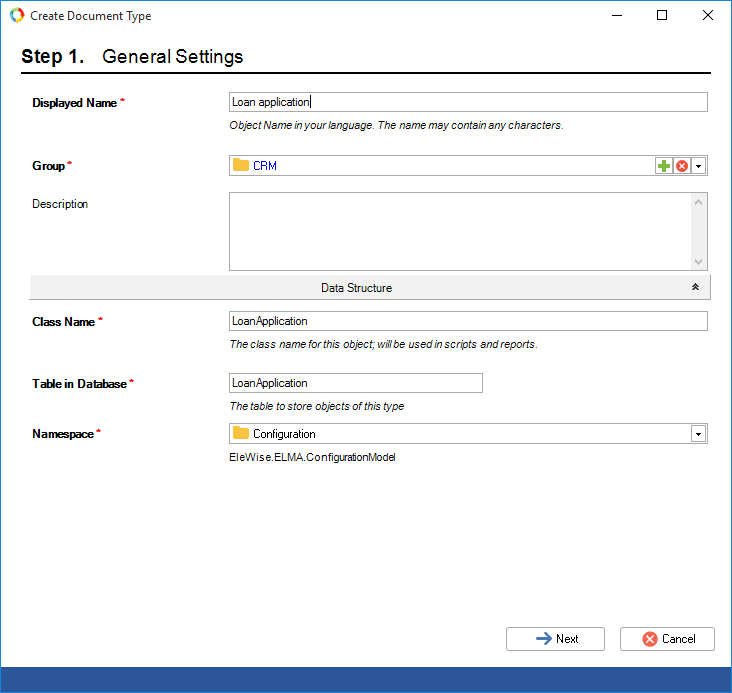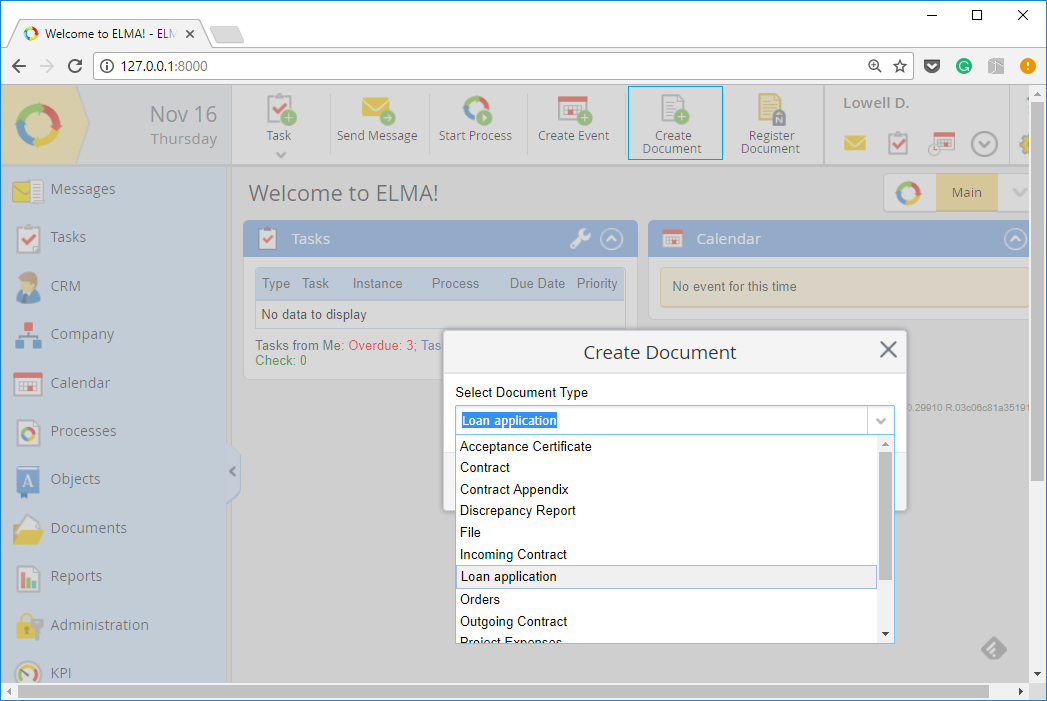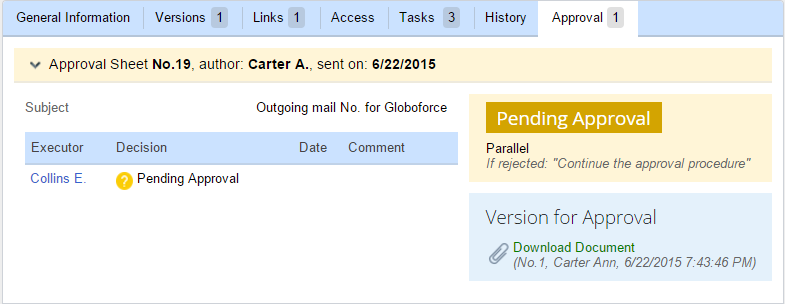Creating a document in ELMA
A document in ELMA is a page with certain properties and an attached file with the document. The featured properties depend on the document type. Document types are created and configured in ELMA Designer in the Document Management tab.
Creating document types
To create a new document type, open the Document Management tab in ELMA Designer. On the left, there is a list of all the documents that exist in the system. On the right, there are tabs with document types that are open at the moment.
Then open the context menu and select Create document type or click Add in the top menu bar.

Fig. 1. Context menu
First, introduce the name of the document type as you want it to be displayed in the system.

Fig. 2. Step 1 Document type creation wizard
The second step is to configure the system settings. Leave them as they are and click Next.
The third step shows the properties inherited from the base document type. To add a new property, right-click on the list of properties and select Add property.
.png)
Fig. 3. Step 3 of the creation wizard
On the fourth step, you can specify a template for generating names for documents of this type. For example, Invoice issued on {$Document.CreationDate}», where {$Document.CreationDate} will be automatically changed to the date the invoice was issued. To add a document property into the template, click Add document property. You will see a list of all available document properties.
When you click Next, a tab will open where you can edit the properties of the document type and configure additional parameters.
In the Forms tab, you can configure view, creation and edit forms for documents of this type. The forms are edited in the built-in form editor, you can read more about it in ELMA Help.
In the Routes tab, you can configure document routes for handling this document type.
Once you have configured the document type, you need to publish it. For that, click Save - Publish. ELMA will also require you to restart the server.
After the document type is published, users are able to create documents of this type in ELMA.
For that, a user has to click Create document in the top menu and then select the document type in the appeared window. The document types used last are shown separately for your convenience.

Fig. 4. Creating a document in ELMA Web Application
After the document type is selected, a creation form opens. There, you have to fill the properties previously specified in ELMA Designer, and attach the document file.
.png)
Fig. 5. Filled in document properties
You can upload the document file from your computer, make a scan using ELMA Agent, or generate it from a template if certain specific settings are configured. In this case, document properties can be automatically added to the file.
The document is saved to the selected folder. All the folders are displayed in the left menu.
General information
When you click on the document name, the document page opens. It contains several tabs, which feature document properties.
The first tab shows the general information about the document: name, author, date of creation, comments, current version and approval results

Fig. 6. General information tab
The Versions tab shows all the document versions, their statuses, authors, and dates of modification. Here you can add a new file or view, edit and changes statuses of the files already attached.

Fig. 7. Versions tab
In the Links tab, you can create and view the links between this document and other documents in ELMA. For example, a commercial proposal can be added to a contract and therefore linked to the contract's page in ELMA.
To create a new link, click on +Add Links. In the appeared window you can introduce the name of the link and select documents that you wish to link.

Fig. 8. Links tab
If the document is sent for approval or acquaintance, corresponding tabs appear.

Fig. 9. Approval tab
These tabs display information about the completed stages of approval or acquaintance: approval and acquaintance sheets with decisions, comments, and dates.
If there are document-related tasks, they are shown in the Tasks tab. The tab displays information about the author, executor and due date of the task.

Fig. 10. Tasks tab
The Access tab shows the users who have permissions to view, modify and manage access to the document. You can read more about access to documents in ELMA Help.
The History tab shows the history of all changes, comments, questions, and attachments. You can read more about document history in ELMA Help.
